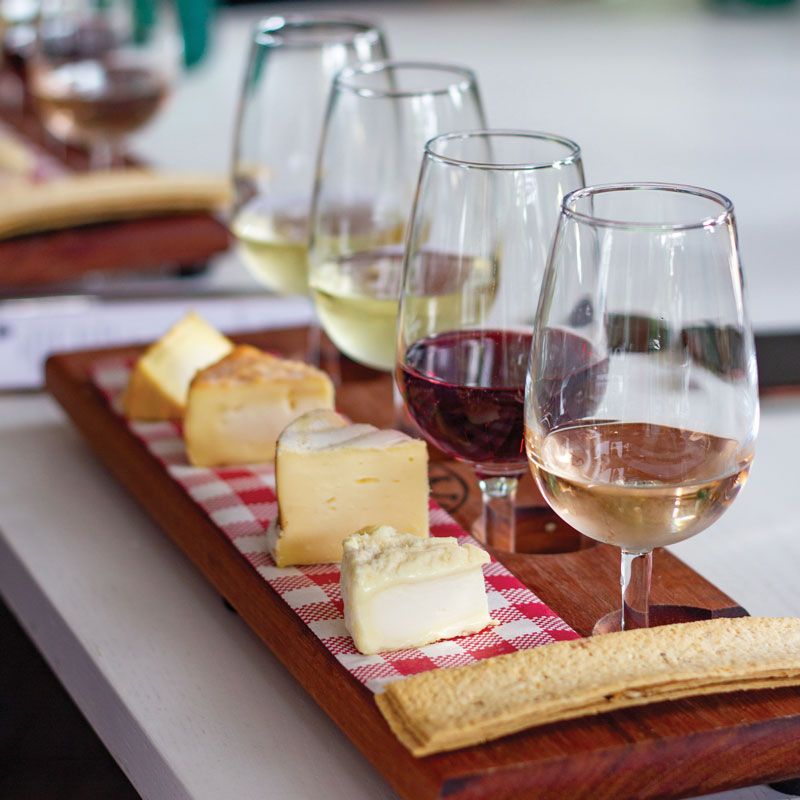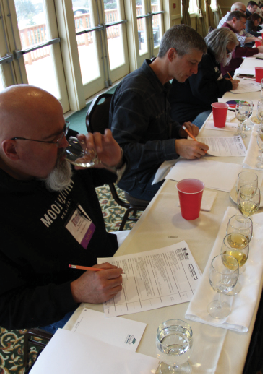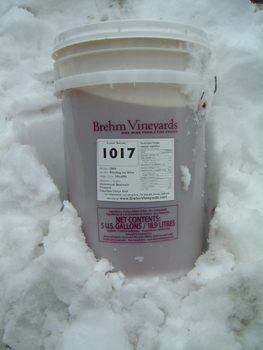Eat this, drink that!” Such advice sums up many attempts at providing guidance for pairing foods with wines. While the pairings that are offered may be perfectly delicious, they seldom provide guidance for branching out and choosing further matches. So what are you to do when you want to showcase a few of your homemade wines with appetizers or a dinner party? In the best pairings, serving them together elevates the esthetic impressions of both the wine and food.
We all have favorite pairings and my goal here is to make those combinations more predictable using science. One group of factors involves the human physiology of taste and smell, along with what is happening chemically during tasting. Armed with some basics, you can launch into pairing trials with more confidence and precision. There’s nothing wrong with experimenting and do not view these guidelines as limits. As always, drink what you like and don’t let anyone tell you otherwise!

If you are arranging a blind date for someone, make sure you are doing them both a favor. Food-wine pairing is like that, too. You want the food and the wine to show better, raising what we might call the overall “hedonistic index.” Before the 19th century, this subject scarcely existed. When wine was consumed, it was mostly whatever was produced locally. Most available foods would be local and seasonal. Rising wealth in the Industrial Revolution brought options to enjoy more than one wine at a single meal and many of the classic pairings began to develop. As home winemakers, we also have the opportunity to showcase multiple wines.
The first pairing principle is “like with like.” This is seen in regional wines and foods that support the idea of what grows together goes together. People look for similar characteristics in the food and the wine, with many classic pairings still popular. In Larousse’s Encyclopedia of Wine are such combinations as caviar and Champagne, sole with white Burgundy, and game meats with red Burgundy. Over time, some of these ideas were simplified to white with fish, red with meat. The other great pairing foundation is deliberate contrast. Examples of this approach include such pairings as sweet dessert with even sweeter wine or crisp Champagne served with fatty meats.
To make your pairings, look at features that may show up in both food and wine, and then align them. Examples include aromas and flavors like fruity, meaty, smoky, earthy, and many others. The reasons such combinations bring pleasure side-by-side comes down to the physiology of taste. I am using “taste” to represent the complex interaction of chemical signals from taste receptors in the mouth combined with odor signals from olfactory receptors. While some discussions distinguish “aroma” from “bouquet” and “taste” as exclusively from taste buds, I am combining all of those sensory attributes for pleasurable pairings.
Contrary to what many of us were taught, there is not a “tongue map” of some taste buds over here and others over there. Rather, taste buds are distributed all across the tongue and elsewhere on mucus membranes of the mouth. What remains true from school is the first four basic taste receptor types: Sweet, sour, bitter, and salt. There’s one more, which has become widely recognized in modern times: Umami or “savoriness.”
In addition to these chemical receptors of tastes, our mouth tissues provide physical signals like fatty, sticky, “hot” (or irritating), and astringent. In contrast to these few oral features, humans can recognize and identify upwards of 10,000 different odors. By their physical nature, odors are volatile compounds presented to the olfactory bulb, producing a signal. Chewing and warming may increase volatility and ease of detection. There are two routes to the olfactory bulb: Direct sniffing through the nose as well as the retronasal passage at the back of the palate. The brain combines the signals in creating the overall impression of smell.
There are differences between tasting wine and food. One is the presence of alcohol (ethanol) in wine. With a boiling point of 173 °F (78 °C), ethanol adds volatility to wine, helping to lift aromas for detection. Wine also contributes many aromas that help us recognize it as wine or as a particular variety of wine. The ethanol volatility helps transport less volatile compounds to the olfactory sensors. When it comes to the five tastes, all of them may be present in food. Wine, though, generally lacks salt and umami flavors, so those are not available to match in pairings. Instead, look at sweet, sour, and bitter. Sweetness in wine may come from residual sugar, glycerol, or ethanol (at moderate levels). Sour character comes from wine acids including tartaric, malic, and lactic. Bitterness comes from grape polyphenolic compounds called flavonoids and possible tannins from oak aging.
Then there are the physical sensations from wine. In On Food and Cooking, Harold McGee describes the effects of wine tannins in the mouth as they “cross link with the surface proteins and cause the tissues to contract slightly.” That’s the feeling of drying, astringency, that comes from dry red wines. Meanwhile, higher levels of ethanol and other alcohols may cause irritation of the oral membranes and are perceived as “hot.” Together astringency and alcohol produce what we think of as “body” in a wine.
Keys To Matching Wines and Food
For full-bodied wines, you want similarly full-bodied foods. Look for robust, strongly flavored foods, but stay away from hot-pepper spices, as those may compound the irritation from alcohols. For light-bodied red wines or most white wines, look to lighter foods like vegetables, herbaceous spices, seafood, and other delicate meats. To accommodate your wine’s body, you can measure (or estimate) the alcohol level as one indicator. For the other, the tannin contribution, laboratory testing is available but for home use you can just trust your palate.
You can measure your wine’s acidity, so you will know if it is high or low. To match with high-acid wines, look to high-acid foods like salad dressings or sauces with vinegar or citrus. If you want to try a contrast pairing, try fatty foods like meats, cheeses, and cream sauces. To match with low-acid wines, mild foods like hummus, potatoes, or bread can work well. If you want to contrast with low-acid wine, you can try spicy foods, which also play into the next feature: Sweetness. One successful contrast pairing is to use spicy Latin or Asian foods to contrast with a sweet wine. In pairing with very sweet foods like pastries or cream desserts, try pairing an even sweeter wine. Use your testing of your wine’s residual sugar to predict its sweet effects.
You want the food and the wine to show better, raising what we might call the overall “hedonistic index.”
For bitterness and astringency, there are no common home tests for your wine. Rely on your palate instead, and if you have a bitter or astringent wine, a contrast pairing usually works best. Go with mild and slightly sweet foods for a pleasing pair. If you want to pair with bitter foods like arugula, walnuts, or blue cheese, try a mild wine or one with some sweetness. Finally, consider the overall character of your wine and match that with the overall character of the food. That is, groups of flavors like fruity, meaty, or earthy can be matched in both food and wine.
Now you are ready for your pairing plan. Consider your wine features of variety, acid, sweetness, body, and overall impression. In your foods, consider sweetness, sourness, bitterness, and overall impression. Choose to match specific food and wine attributes, contrast specific attributes, or match the overall impression of each. For a meeting of our local home winemaking club we had four volunteers bring in wines and we paired each with two different food bites. The bites were selected using the principles laid out here and the winemakers provided the following data about their wines:
- A Russian River Chardonnay with fairly high acid level, low pH, and 12 months of sur lie aging. Pairings were a chilled, boiled shrimp and a cube of Brie cheese. The goal with the shrimp was to match the delicate flavor with the white wine while still offering enough body to meet the relatively “big” texture of a Chardonnay. The fatty Brie would echo fermented notes from aging and offer fatty mouthfeel to offset moderately high acidity. Both pairings were well received.
- A Tempranillo rosé with a pH of 3.54, titratable acidity (TA) of 6.2 g/L, and alcohol (ABV) of about 13%. Here one food we paired was a bite of ham, looking for contrast with the brightness of the wine. The other was a strawberry to echo the fruitiness and acid. In this case, the ham worked very well but some tasters found the acid-on-acid tartness of the strawberry did not present well with the wine.
- A Pinot Noir with a pH of 3.17, TA of 6.3 g/L, and ABV of about 13.5%. We paired it with a sautéed mushroom, looking for an earthy impression match and fatty character to balance acid and tannins. Baked salmon, the other pairing, also had fatty contrast with tannins and acids, but added a meaty impression. The mushroom was good, but not outstanding, perhaps because the Pinot was young and bright, not presenting much varietal earthiness. The salmon proved an excellent pairing, with the young wine presenting very well and contradicting the simple “white wine with fish” rule.
- A Cabernet Sauvignon with a pH of 3.44 and a TA of 8.2 g/L. The alcohol was about 13.7% and the wine was aged in neutral oak with an addition of medium-plus French oak. Foods were rare roast beef and dark chocolate. The rare roast beef made an excellent pairing, with the juicy and fatty meat contrasting nicely with the acid and tannin in the wine. The chocolate was also a good pairing, but did not outshine the beef. This reinforced the axiom: Red wine with meat!
Ready to try your own pairing? Ahead of time, get out a few of your wines, taste them, and look up your original production data. Choose and prepare two or three foods for each wine as described here, invite a few trusted friends, and see if the science works for you.






